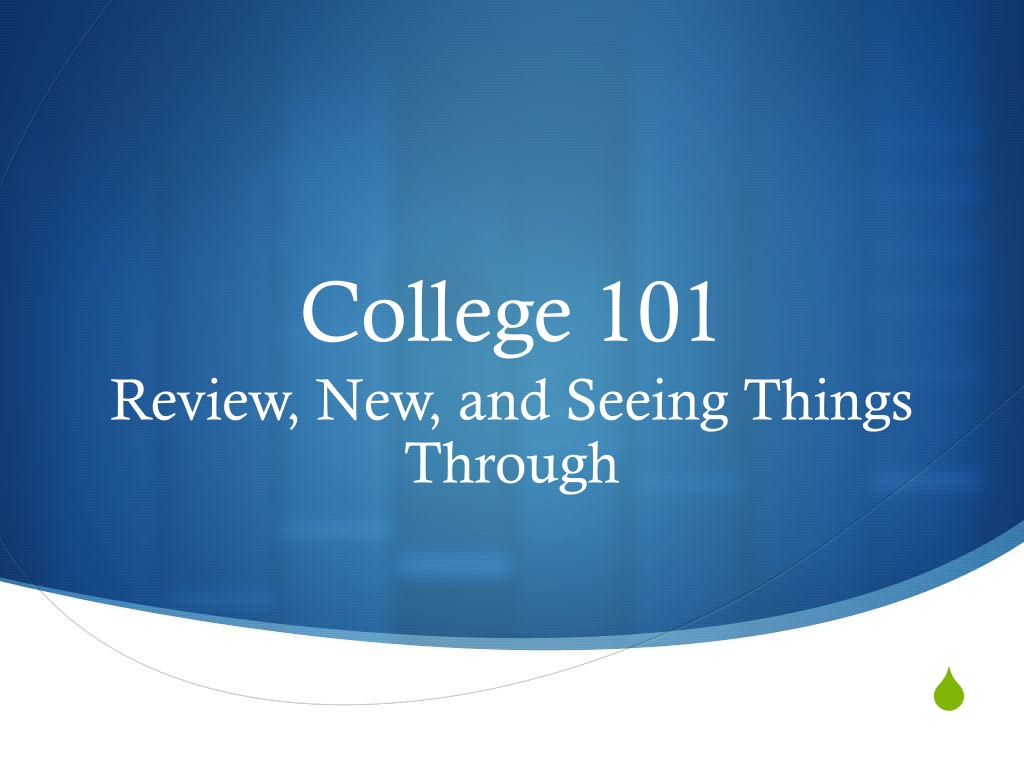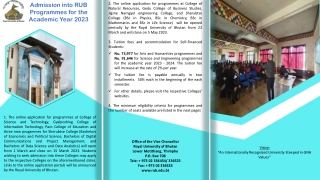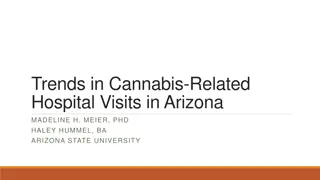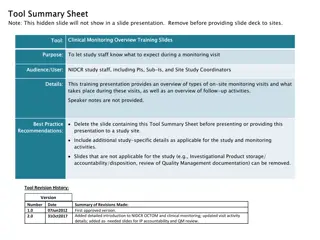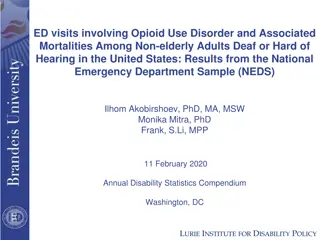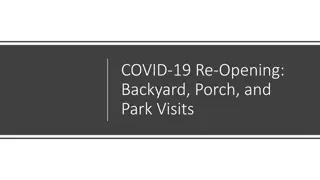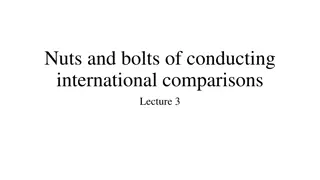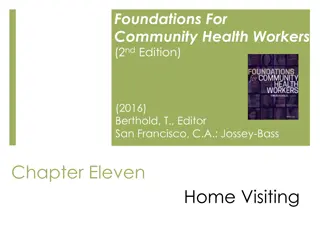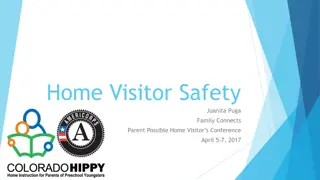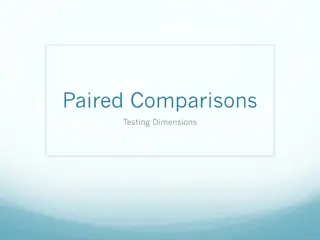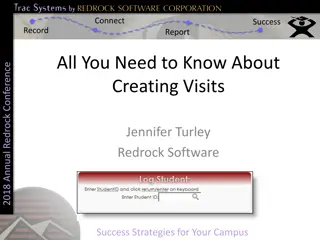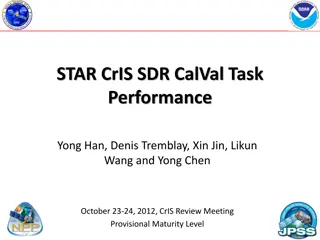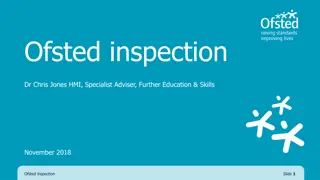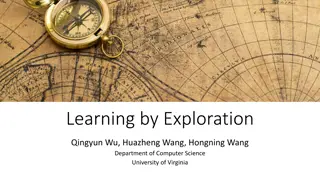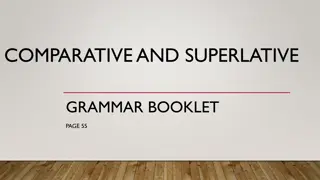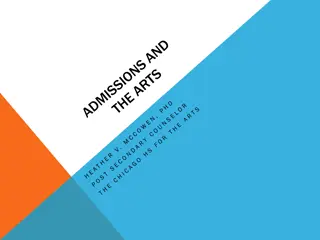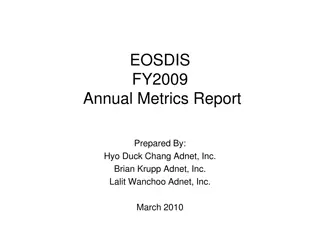College Exploration Guide: Tips for Visits, Applications, and Comparisons
This detailed guide covers essential aspects of exploring colleges, including official visits, application timelines, the Common Application, and comparing different types of colleges. Discover tips on when to apply, utilizing the Common App, and comparing public, private, and specialty schools to make informed decisions for your future education.
Download Presentation

Please find below an Image/Link to download the presentation.
The content on the website is provided AS IS for your information and personal use only. It may not be sold, licensed, or shared on other websites without obtaining consent from the author. Download presentation by click this link. If you encounter any issues during the download, it is possible that the publisher has removed the file from their server.
E N D
Presentation Transcript
College 101 Review, New, and Seeing Things Through
College Visits What: Make an official college visit Who: Rising juniors and seniors plus younger siblings When: Summers after 10thand 11thGrade; high school spring break; at tournaments/summer camps Which: Variety of types (private, public, local, and community) How: Reserve tour spot online or by calling admissions Make special requests: visit with a coach, sit in on a lecture, meet with a professor, if student has special needs meet with disability services office Rule of Thumb #1: Never go to a college without having taken an official campus tour.
When to Apply August and September of senior year is the time to apply SHA Goal: All apps in by Halloween at the latest Early Decision/Early Notification Deadline: November 1st Regular Decision Deadline: January 1st Rolling Admission: Students can apply through the first week of the semester
The Common Application Over 500 colleges and universities across the United States use the Common Application 10 allow it in Michigan: U of M (required), Albion, Alma, Calvin, Hope, and other private schools Application that is available to any accepting school Application fees per institution apply Holistic Approach Extracurricular activities, letters of recommendation, essay and supplemental question responses (these may be required for certain schools) Available August 1st www.commonapp.org
Comparing Colleges 15 Public: MSU, SVSU, CMU, U of M 40+ Private: Alma, Aquinas, Albion Community College: Delta, Mid-Michigan, Lansing CC Approximately of Bachelor s degree students earn credit from a community college Specialty Schools: Kendall College of Art and Design, MJ Beauty College
Comparing Colleges Naval Reserve Officers Training Corps (NROTC) University of Michigan-Ann Arbor and Dearborn Eastern Michigan University Army ROTC CMU, EMU, U of M, FSU, MSU, NMU, WMU, MTU and many others Air Force ROTC EMU, U of M, MTU, WSU, and many others
Comparing Colleges Most selective (acceptance rate: 5-8%): Harvard, Stanford, Yale, Princeton, Columbia Highly selective (acceptance rate: 8-15%): US Naval Academy, MIT, Northwestern, Duke Selective (acceptance rate 20-33%): Notre Dame, UNC, Boston College, NYU, Michigan Michigan Selective: Michigan, MSU, GVSU Less Selective (acceptance rate 60-90%): CMU, Alma, SVSU, NMU Community Colleges
Academic Requirements Most/Highly Selective: 3.8-4.0; 34-36 ACT composite Selective: 3.7-4.0; 32-36 ACT composite Less Selective: 2.5-3.5; 17-26 composite Community College: 2.0 and below; ACT not required with a placement test ACT v SAT SAT II, SAT Subject tests 2-3 are required by highly selective schools Some schools prefer one test in a subject related to academic major Take SAT Subject tests when completed a related subject Ex. Biology at the end of Freshmen year
Academic Requirements Course selection AP vs. Dual Enrollment Extracurricular Activities Essays Recommendations
Grade Point Average Cumulative GPA is based on semester grades Religion grade is factored into GPA One of the first things colleges look at when considering applicant Rule of Thumb #2: Truly learning is more important and lasting than earning a good grade. Academic Scholarships-3.5 and above Private Scholarship-3.0-3.5 and above
ACT v. SAT Accepted by every college/university http://www.actstudent.org/faq/actsat.html 2016-2018: SHA will offer SAT for free through MDE Register for ACT at CMU: act.org Recommendation (no more than 2-3 times per test) 1-SAT 1-ACT 1-SAT or ACT (better of the two based on first test results)
How to Prepare SHA ACT/SAT Prep Course: June 13-17, 2016 Practice tests, practice tests, practice tests Timing Format Types of questions Vocabulary Online practice problems Test prep books-vary in effectiveness Khan Academy-khanacademy.org
Extracurricular Activities Depth over breadth Demonstrates leadership Follow passions should be purpose, a resume should be the result School clubs/organizations, athletics, jobs, volunteerism (consistent, meaningful), community activities Listen to Announcements: HOBY/MYLEAD, summer leadership and academic camps, Joyce Ivy, STEM events, essay contests, CMU Health Careers Pipeline, Inland Seas Summer Program, etc.
Essays Less selective schools do not require an essay, may require a 1-2 short answer responses Essay is what sets applicant a part among thousands Rule of Thumb #3: Purpose: Make the college want you there. Your essay should not be a general summary of you, but one or two aspects of you that will make you stand out. How you write the essay is more important than what is being described. Ex. I am curious. What makes you curious? How does that feel? Could you use figurative language to deepen the description? Avoid overusing clich s/metaphors Write essay as far in advance as possible Ask others for feedback, but beware of listening to too many voices It may take multiple attempts
Letters of Recommendation Rule of Thumb #4: Ask for letters before you leave for summer after junior year. Politely give a deadline and follow up with recommender Teachers, advisor, priest, coach, employer Ask 3-4 people for a letter It s ok to give recommenders a focus for their letter; Ex. leadership Provide a resume People who know you best Give the recommender the option to say no Give a handwritten thank you note to each recommender
How to Choose? Conversation with student prior to junior/senior year College Visits College Nights-CMU hosts one annually the last week in September Research schools and programs Talk with teachers, coaches, and other students who attended universities you are considering
How to Choose? Academic Major/Program 1. Direct admit 2. How many are allowed in program? 3. Is the program marketable in 21stcentury economy? 1. Career Cruising Job Shadowing 1. 2. Cost (Current avg. debt $25,000) 1. In-state vs. Out-of-State 2. Fees/Tuition increases with higher level courses 2. Location 3. Atmosphere/Size 4. Name Recognition/Family Legacy 5.
Student-Athletes Register with the NCAA ($70.00) and/or NAIA ($70.00) Eligibility Centers during or before junior year NCAA Audit w/counselor before junior year 16 core courses required (10 prior to senior year) for Division 1 Sliding scale GPA/ACT requirements Request transcripts Send ACT scores to NCAA Eligibility Center when registering for test Rule of Thumb #5: Communicate with high school coach early and often about your goal for college athletics. Locate video of best complete game
Applications Do not over apply! Avg. Application fee = $30-75 5 applications (1 Dream, 1 Local, 2-3 Realistic Options) Early Decision/Acceptance vs. Early Notification (non- binding) Rule of Thumb #6: Verify appropriate social media use
Application Necessities Transcripts In-state: parchment.com and Out-of-State: ask counselor ACT on transcript Some schools require scores be sent directly from ACT Dual enrollment transcripts must be requested from DE college directly Resume/CV Extracurriculars Church Involvement Awards/Recognition Community Service Quality over Quantity Student Initiated Don t stop at 100 Future Goals
How America Pays for College https://www.salliemae.com/plan-for-college/how-america- pays-for-college/ http://www.usnews.com/news/articles/2014/02/11/study -income-gap-between-young-college-and-high-school-grads- widens
Cost of Attendance Most/Highly Selective: $40,000-60,000 per year Selective: $25,000-40,000 per year Less Selective: $17,000-25,000 per year Community College: $15,000-18,000 per year Sticker Price v. Actual Price http://studentnpc.collegeboard.org/ http://www.michigan.gov/documents/mistudentaid/Guidebook_ 201516_498539_7.pdf
Scholarships Attend Awards Night prior to senior year Begin researching ASAP senior year Academic/Merit Based (automatic, competitive) 1. University Scholarships (majors, alumni family members, locations) 2. Private Scholarships (local organizations, MPACF, Watson Foundation, VFW, parents employment, grandparents groups, churches, credit unions)-Check RenWeb scholarship list and talk with Ms. Richards 3. State/National Scholarships (first family member in college, uncommon majors, religion/ethnic group)-Search Online; useful web site can be found at www.michigan.gov/ssg 4. Be mindful of scholarship college GPA requirements Rule of Thumb #7: Never pay money to apply for a scholarship and no scholarship is ever guaranteed. Scholarship Search=full-time job but 1 page essay = $1,000 Write thank you note in timely manner (within one week)
Financial Aid Free Application for Federal Student Aid (FAFSA) www.fafsa.ed.gov Available January 1st Must be filed for student to receive any aid from college Michigan deadline to submit March 1st, some colleges it is earlier College Scholarship Services Profile (CSS) Required by certain schools Available October 1st Due earlier than FAFSA
Types of Financial Aid Grants Federal Pell Grants: up to $5,550 per year, based on need/cost of attendance FSEOG Grants: determined by college, based on exceptional financial need TEACH Grants: must commit to teaching in low-income school district Iraq and Afghanistan Military Grants T.I.P. qualifiers will receive information from the govt.
Types of Financial Aid Loans Federal Perkins Loan Program: determined by colleges, based on need, amount of other aid received, and funds available Direct Loan Program: Stafford-available to students, subsidized or unsubsidized Direct Plus-available to parents of dependent students, only unsubsidized Subsidized-based on financial needs (undergrad only), govt. pays the interest on the loan while borrower is in college or deferment; $3,500-5,500 Unsubsidized-based on education s cost and other aid received, borrower must pay all accrued interest on loans; $5,500-20,500 Private/Alternative Loan: eligibility, interest rate, and fees based on credit scores Work-Study Program Rule of Thumb #8: You can t win a scholarship or receive financial aid if you don t apply.
Ways to Save Money Community College for General Education Requirements Dual Enroll AP Exams ($91)/CLEP testing ($80) Select less expensive meal plan More roommates reduces rent/room and board Skip the parking permit Summer jobs starting in high school Work while in college/Residential Advisor Use loan and scholarship money only for school fees Purchase books online/see if you really use the book in the course before purchasing Split dorm room items with roommate/limit yourself at Bed, Bath, and Beyond Military (Make sure males register with Selective Service within 30 days of 18thbirthday)
Housing Accepted students receive information January/February Roommate(s) vs. Private Residential Survey Don t be afraid to go in blind Small to medium meal plans usually enough Mindful of deadlines (earlier is better) Honors/Scholars Students Housing Perks Non-refundable deposit Meningitis vaccination On-campus vs. Off-campus housing Call Local and Campus police for safest on-campus and off-campus housing
Orientation Information sent home in spring Sign up for earliest orientation date/parents requested to attend Usually begin in early May Some are two-day orientations Confirmation of attendance Additional deposits may be due Placement testing ACT sub scores do matter Make sure college has dual enrollment transcripts prior to scheduling Schedule classes to allow for work, travel time, practice Take most time consuming courses during summer semesters
Last Steps Notify schools that you are not attending Request final transcripts from counselor Make sure AP/CLEP scores received by college Sign-up for student organizations/attend welcome week activities Find out local Mass schedules Meet with college advisor regularly Build relationship with professors-visit them during office hours Pursue on-campus employment before arriving on campus (Career Planning Office) Internships Go to class!
Before They Go Social Media/Internet Accounts Cook basic meals/brew coffee and tea Pump gas/oil change/change tire Clean/check for bed bugs Secure transportation home in an emergency Personal Safety/Secure medical professionals near college Discretion with credit card companies Weekly Budget/Credit Cards Laundry/Iron Clothes/Sew button Address an envelope Read a map Dress/restaurant etiquette Pay a bill Proper tipping Write a check/balance checking account/develop official signature Research, purchase and/or return goods Phone conversation with professional Know social security and student ID number
Timeline Summary January 1st: FAFSA is available 11thGrade Summer/12thGrade Summer: Official College Visits January-March: On-campus housing sign- up 11thGrade Fall: Register with NCAA or NAIA clearinghouse March 1st: FAFSA is due in Michigan April-May: Register for freshmen orientation 11thGrade Spring: SAT and ACT August 1stof 12thGrade: Common App available May: Send transcripts from DE colleges to university you will be attending May-July: Complete freshmen orientation August-October 12thGrade: Complete Applications June: Send final transcript to college July-August: Tuition is due October-May: Apply for Scholarships
Senior Year Senior picture/Baby picture: yearbook, slideshow, memory book-Please adhere to deadlines! Order cap/gown, invites, etc. through Herff Jones at school Jr/Sr Retreat: Last Friday in November before Thanksgiving; Cran Hill Ranch (Rodney, MI); all-day Service hour requirement must be met by end of 3rdmarking period of senior year to receive diploma at graduation SH Parish Graduation Mass: Sunday in May, wear graduation gown, all SHA graduates invited to attend regardless of faith Final Week of School for Seniors: Monday-Wednesday: Final Exams Wednesday: Jr./Sr. Awards Night in church Thursday: Senior Retreat Friday: Senior Mass, graduation practice, walkthrough, breakfast with parents at Riverwood, and graduation (May 27)
Helpful Sites Career/Job Information careercruising.com mynextmove.org www.bls.gov/ooh Financial Aid finaid.org www.collegecost.edu.gov www.mappingyourfuture.org College Search nces.edu.gov/collegenavigator monstercollege.com Scholarships http://studentaid.ed.gov/types/grants- scholarships/finding-scholarships www.michigan.gov/ssg fastweb.com collegeboard.org edudaris.com mpacf.org jrwatsonfoundation.org mycollegeoptions.org/MI/0/Michigan www.petersons.com ACT/SAT act.org and collegeboard.org NCAA Eligibilitycenter.org Military www.gibill.va.gov
